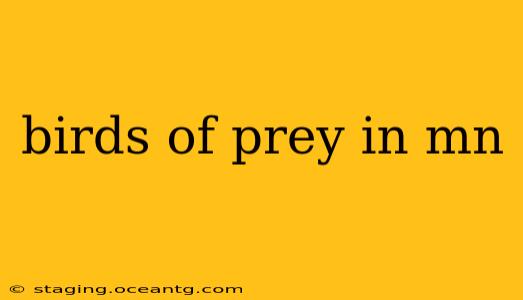Minnesota, with its diverse habitats ranging from boreal forests to prairie grasslands, offers a rich tapestry of wildlife, including a fascinating array of birds of prey. These majestic hunters, with their sharp talons and keen eyesight, play a crucial role in maintaining the state's delicate ecosystem. This guide explores the various raptors found in Minnesota, their habitats, and conservation efforts.
What types of birds of prey are found in Minnesota?
Minnesota is home to a variety of bird species classified as birds of prey, also known as raptors. These include eagles, hawks, owls, falcons, and ospreys. Some are year-round residents, while others migrate through or to the state for breeding or wintering. Common species include the Red-tailed Hawk (a very common sight across the state), the Great Horned Owl (easily identified by its large size and ear tufts), and the Bald Eagle (a magnificent sight, especially near larger bodies of water). Others, like the Peregrine Falcon, are less frequently encountered but still represent an important part of Minnesota's avian diversity.
Where can I see birds of prey in Minnesota?
Spotting birds of prey often depends on the species and the time of year. However, several locations in Minnesota offer excellent opportunities for raptor viewing. State parks and wildlife management areas frequently provide suitable habitats. Areas with open grasslands, wetlands, forests, and bodies of water are particularly attractive to various raptors. For example, the vast prairies of western Minnesota can offer sightings of ferruginous hawks and northern harriers. Meanwhile, areas with mature forests and abundant prey provide suitable habitat for owls such as Great Horned Owls and Barred Owls. Larger lakes and rivers are important hunting grounds for Bald Eagles and Ospreys. Remember to use binoculars and spotting scopes for better viewing and to respect the birds' habitat.
What are some of the most common birds of prey in Minnesota?
Several raptors are particularly common within Minnesota's borders. The Red-tailed Hawk, as mentioned earlier, is arguably the most widespread and easily identifiable hawk. Its distinctive red tail is a key identifying feature. The Great Horned Owl, with its impressive size and characteristic ear tufts, is a common nocturnal hunter found in various habitats across the state. The Bald Eagle, a national symbol, has made a remarkable recovery and can now be observed relatively frequently near suitable water sources. Other common species include the American Kestrel, the smallest falcon in North America, and the Northern Harrier, a marsh-dwelling hawk often seen hunting low over grasslands.
Are there any endangered birds of prey in Minnesota?
While the conservation status of many raptors in Minnesota is positive thanks to conservation efforts, some species remain vulnerable or are under close monitoring. The specific designations and levels of endangerment can change, so it's crucial to consult up-to-date information from the Minnesota Department of Natural Resources (DNR) or reputable ornithological organizations. Factors such as habitat loss, pesticide use, and collisions with human structures continue to pose threats to these magnificent birds.
What is the best time of year to see birds of prey in Minnesota?
The best time to observe birds of prey in Minnesota depends largely on the species and their migratory patterns. Spring and fall migrations offer increased chances of seeing a greater diversity of species. During the breeding season (spring and summer), raptors may be more visible as they actively defend their territories and raise their young. Winter offers excellent opportunities to observe resident species like the Great Horned Owl and the Bald Eagle. However, cold weather might make sightings slightly less frequent.
How can I help protect birds of prey in Minnesota?
Protecting birds of prey requires a multifaceted approach. Supporting conservation organizations dedicated to raptor research and protection is essential. Responsible land management practices that preserve and enhance critical habitats are also vital. Reducing the use of harmful pesticides and minimizing human-wildlife conflict are key steps in ensuring the survival of these magnificent creatures. Educating others about the importance of birds of prey and their role in the ecosystem is equally vital. By raising awareness and actively supporting conservation, we can help these majestic birds thrive in Minnesota for generations to come.
Author Note: This information is for general knowledge and enjoyment. For the most up-to-date information on bird conservation in Minnesota, please consult the official Minnesota Department of Natural Resources website.
